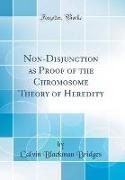Read more
Excerpt from Non-Disjunction as Proof of the Chromosome Theory of Heredity
There are now about fifty sex-linked mutations known in Drosophila, and the data collected in their investigation are the most extensive known in experimental breeding. The arrangement of the sex-linked genes in a linear series and the establishment of the relative distances between the loci are based upon over half a million ¿ies.4 The work on non disjunction deals directly with the best known of these sex-linked char acters, and therefore rests upon a very firm Mendelian foundation.
The inheritance of a recessive sex - linked character may be illustrated by the cross of a vermilion female by a wild type (red - eyed) male (see figure The sons are vermilion - eyed like the mother, and the daugh ters are wild type like the father. This criss - cross inheritance is ex plained by the theory that the genes for the sex - linked characters are carried by the X chromosomes. As shown in figure 2, the son derives his single X chromosome from his mother, and shows vermilion eye color because the gene for vermilion was carried by that chromosome. The Y chromosome from the father does not affect the visible characters of the son in any way. Thus a male always shows by its characters what genes are carried by its X chromosome. The daughter receives from the mother an X carrying the vermilion gene, but since the vermilion is recessive to the unmutated gene (red) carried by the X which she re ceives from the father, she will be wild type (red).
About the Publisher
Forgotten Books publishes hundreds of thousands of rare and classic books. Find more at www.forgottenbooks.com
This book is a reproduction of an important historical work. Forgotten Books uses state-of-the-art technology to digitally reconstruct the work, preserving the original format whilst repairing imperfections present in the aged copy. In rare cases, an imperfection in the original, such as a blemish or missing page, may be replicated in our edition. We do, however, repair the vast majority of imperfections successfully; any imperfections that remain are intentionally left to preserve the state of such historical works.

